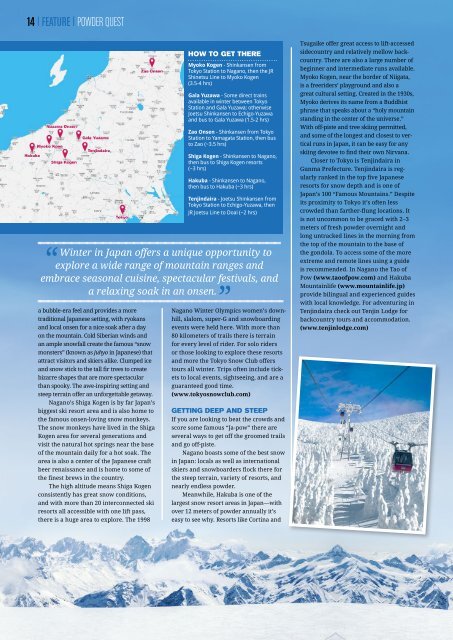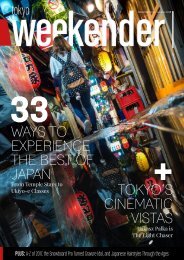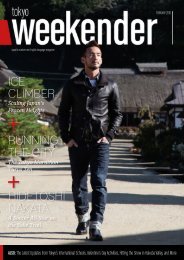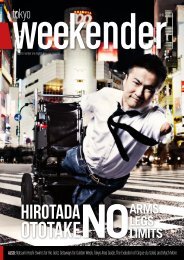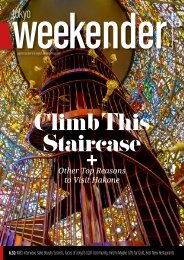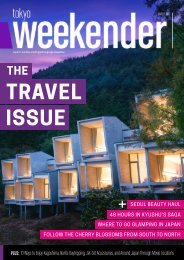Tokyo Weekender - January 2016
Looking back at the year that was. How to Stay True to Your Resolutions Snowboarding & Skiing in Honshu.
Looking back at the year that was. How to Stay True to Your Resolutions Snowboarding & Skiing in Honshu.
You also want an ePaper? Increase the reach of your titles
YUMPU automatically turns print PDFs into web optimized ePapers that Google loves.
14 | FEATURE | POWDER QUEST<br />
a bubble-era feel and provides a more<br />
traditional Japanese setting, with ryokans<br />
and local onsen for a nice soak after a day<br />
on the mountain. Cold Siberian winds and<br />
an ample snowfall create the famous “snow<br />
monsters” (known as juhyo in Japanese) that<br />
attract visitors and skiers alike. Clumped ice<br />
and snow stick to the tall fir trees to create<br />
bizarre shapes that are more spectacular<br />
than spooky. The awe-inspiring setting and<br />
steep terrain offer an unforgettable getaway.<br />
Nagano’s Shiga Kogen is by far Japan’s<br />
biggest ski resort area and is also home to<br />
the famous onsen-loving snow monkeys.<br />
The snow monkeys have lived in the Shiga<br />
Kogen area for several generations and<br />
visit the natural hot springs near the base<br />
of the mountain daily for a hot soak. The<br />
area is also a center of the Japanese craft<br />
beer renaissance and is home to some of<br />
the finest brews in the country.<br />
The high altitude means Shiga Kogen<br />
consistently has great snow conditions,<br />
and with more than 20 interconnected ski<br />
resorts all accessible with one lift pass,<br />
there is a huge area to explore. The 1998<br />
HOW TO GET THERE<br />
Myoko Kogen - Shinkansen from<br />
<strong>Tokyo</strong> Station to Nagano, then the JR<br />
Shinetsu Line to Myoko Kogen<br />
(3.5-4 hrs)<br />
Gala Yuzawa - Some direct trains<br />
available in winter between <strong>Tokyo</strong><br />
Station and Gala Yuzawa; otherwise<br />
Joetsu Shinkansen to Echigo-Yuzawa<br />
and bus to Gala Yuzawa (1.5-2 hrs)<br />
Zao Onsen - Shinkansen from <strong>Tokyo</strong><br />
Station to Yamagata Station, then bus<br />
to Zao (~3.5 hrs)<br />
Shiga Kogen - Shinkansen to Nagano,<br />
then bus to Shiga Kogen resorts<br />
(~3 hrs)<br />
Hakuba - Shinkansen to Nagano,<br />
then bus to Hakuba (~3 hrs)<br />
Tenjindaira - Joetsu Shinkansen from<br />
<strong>Tokyo</strong> Station to Echigo-Yuzawa, then<br />
JR Joetsu Line to Doai (~2 hrs)<br />
Winter in Japan offers a unique opportunity to<br />
explore a wide range of mountain ranges and<br />
embrace seasonal cuisine, spectacular festivals, and<br />
a relaxing soak in an onsen.<br />
Nagano Winter Olympics women’s downhill,<br />
slalom, super-G and snowboarding<br />
events were held here. With more than<br />
80 kilometers of trails there is terrain<br />
for every level of rider. For solo riders<br />
or those looking to explore these resorts<br />
and more the <strong>Tokyo</strong> Snow Club offers<br />
tours all winter. Trips often include tickets<br />
to local events, sightseeing, and are a<br />
guaranteed good time.<br />
(www.tokyosnowclub.com)<br />
GETTING DEEP AND STEEP<br />
If you are looking to beat the crowds and<br />
score some famous “Ja-pow” there are<br />
several ways to get off the groomed trails<br />
and go off-piste.<br />
Nagano boasts some of the best snow<br />
in Japan: locals as well as international<br />
skiers and snowboarders flock there for<br />
the steep terrain, variety of resorts, and<br />
nearly endless powder.<br />
Meanwhile, Hakuba is one of the<br />
largest snow resort areas in Japan—with<br />
over 12 meters of powder annually it’s<br />
easy to see why. Resorts like Cortina and<br />
Tsugaike offer great access to lift-accessed<br />
sidecountry and relatively mellow backcountry.<br />
There are also a large number of<br />
beginner and intermediate runs available.<br />
Myoko Kogen, near the border of Niigata,<br />
is a freeriders’ playground and also a<br />
great cultural setting. Created in the 1930s,<br />
Myoko derives its name from a Buddhist<br />
phrase that speaks about a “holy mountain<br />
standing in the center of the universe.”<br />
With off-piste and tree skiing permitted,<br />
and some of the longest and closest to vertical<br />
runs in Japan, it can be easy for any<br />
skiing devotee to find their own Nirvana.<br />
Closer to <strong>Tokyo</strong> is Tenjindaira in<br />
Gunma Prefecture. Tenjindaira is regularly<br />
ranked in the top five Japanese<br />
resorts for snow depth and is one of<br />
Japan’s 100 “Famous Mountains.” Despite<br />
its proximity to <strong>Tokyo</strong> it’s often less<br />
crowded than farther-flung locations. It<br />
is not uncommon to be graced with 2–3<br />
meters of fresh powder overnight and<br />
long untracked lines in the morning from<br />
the top of the mountain to the base of<br />
the gondola. To access some of the more<br />
extreme and remote lines using a guide<br />
is recommended. In Nagano the Tao of<br />
Pow (www.taoofpow.com) and Hakuba<br />
Mountainlife (www.mountainlife.jp)<br />
provide bilingual and experienced guides<br />
with local knowledge. For adventuring in<br />
Tenjindaira check out Tenjin Lodge for<br />
backcountry tours and accommodation.<br />
(www.tenjinlodge.com)<br />
JANUARY <strong>2016</strong> www.tokyoweekender.com


